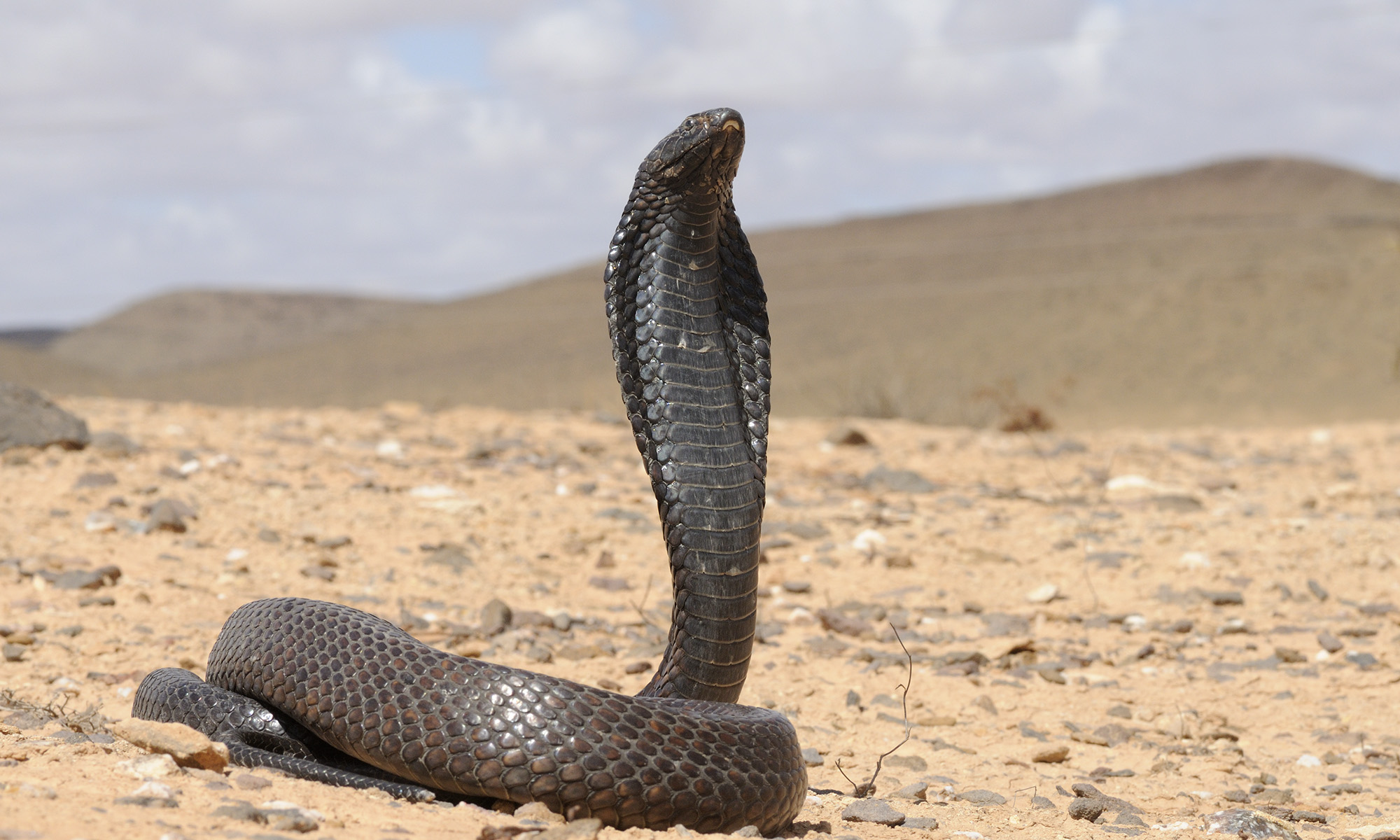Sahara Sand Viper
Cerastes vipera (Linnaeus, 1758)
By Mario Schweiger (Original: 02/08/2012)
Updated: 23/03/2020 (by Gabriel Martínez del Mármol)
Taxonomy: Serpentes | Viperidae | Cerastes | Cerastes vipera
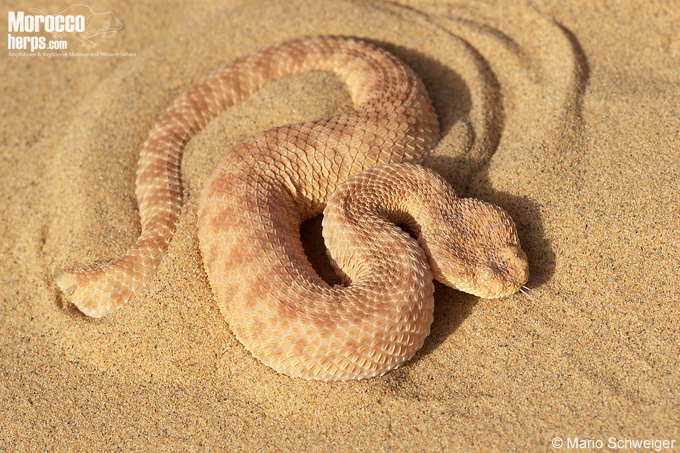
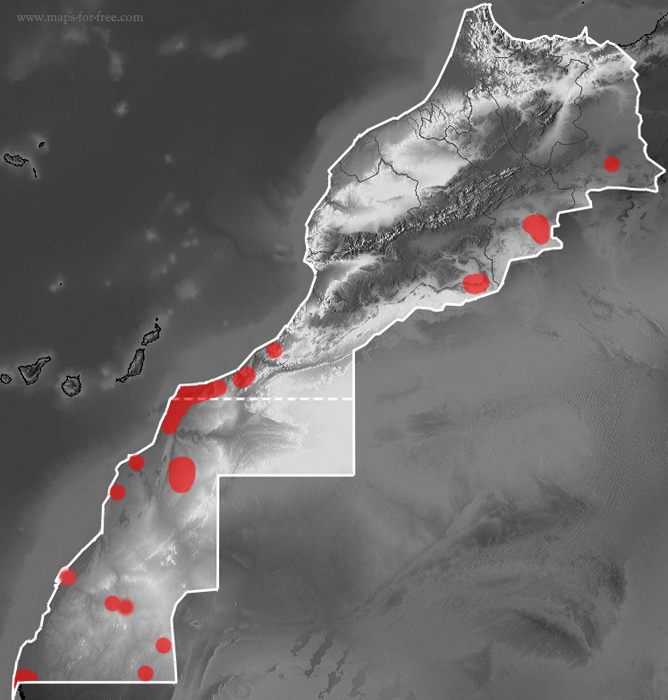
 Cerastes vipera
Cerastes vipera
Distribution map of Cerastes vipera in Morocco.
Gallery: 9 photos. [ENTER]
Phylogenetic frame
Coluber Vipera Linnaeus, 1758
Vipera aegyptiaca Daudin, 1803
Cerastes richiei Gray, 1842
Vipera avicennae Jan,1859
Cerastes vipera Boulenger, 1891
Cerastes vipera inornatus Werner, 1929
Aspis vipera Saint Girons, 1956
The only described subspecies inornatus Werner, 1929 differs from others by having the tail the same coloration as the body. 27 dorsal scale rows are within the range of the species (Baha el Din, 2006). This subspecies has been retracted by Pasteur & Bons, 1960.
Description
A small viper, growing up to 49 cm (Flower, 1933), but mostly between 30 and 35 cm in most cases. Females are significant larger and stouter than males. Scales strongly keeled, which gives a more rough and rugose appearance in contrast to Cerastes cerastes. Three, sometimes four scales between the eye and the supralabials (Schleich et al., 1996). Strauch (1869) examined twelve Avicenna vipers, ten out of had four rows of Suboculars. Body colour beige, brown to orange-red, last coloration especially in the most western part of their distribution. Only fairly marked, except in the coastal areas of southwestern Morocco and Western Sahara, where individuals with contrasting pattern, blue-grey marks and uniformly orange eyes are typical. There is a sexual dimorphsm (dichromatism), females have black tails, while these are in the same colour as the body in males, only getting darker to the tip (Marx, 1958).
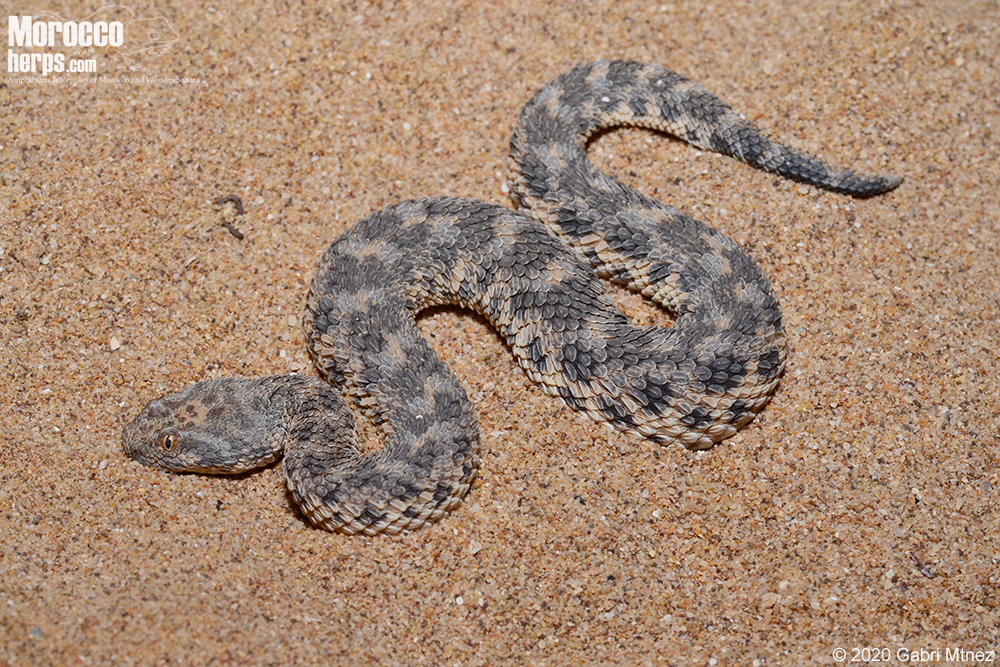
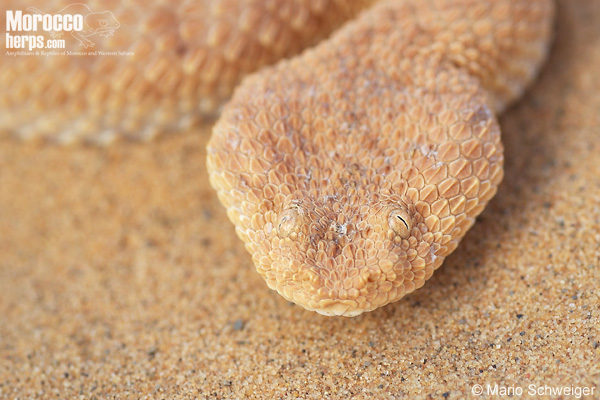
Never with horns above the eyes (compare Cerastes boehmei Wagner & Wilms, 2010 from Tunisia).
Ecology and habits
Avicenna´s viper is a side winder, leaving only J-shaped, not connected tracks on the sand, when being fast on its way.
Cerastes vipera is a caudal lurer, what means, the digged in sand viper puts its tail in front of its head, with the tail tip out of the substrate. When prey comes close, it starts to move its tail tip, resembling a potential prey for the lizard (Neill, 1960; pers. obs.). This might be in causal relationship with the dark to black tail of the viper.
Feeds mostly on lizards (Acanthodactylus, Mesalina, Stenodactylus), but young small rodents are taken as well, especially by the larger females.
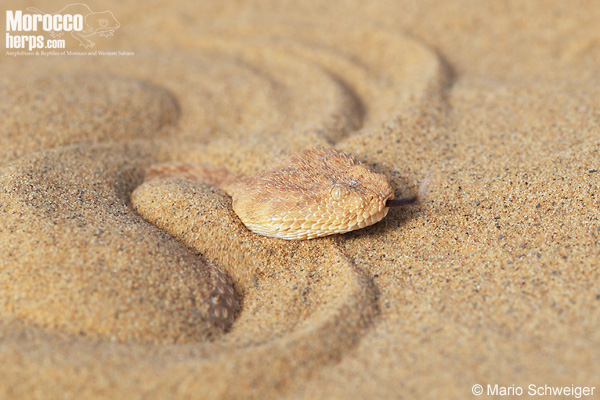
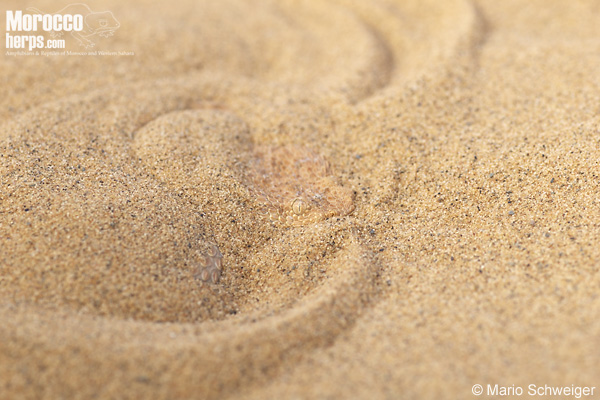
In contrast to all other members of the genus Cerastes, which are egg layers, Cerastes vipera is giving birth to living youngs. But there are old records, Avicenna´s viper is an eggs layer, although the eggs hatched a few hours after deposit (Flower, 1933). Youngs 3 to 6, maximum 8.
In spring and autumn Cerastes vipera is active mostly during the morning and late afternoon hours, while during the hot summer month activity is restricted to the early night hours. During this time of the year, the viper warms up in the upper sand layers of the dunes.
Digs themselves in the lose sand by shovelling motions of the body, starting at the tail.
When disturbed, the viper rubs its serrated lateral scales against each other, producing a rasping sound, like in other members of the genus and Echis. It can also open the mouth showing the fangs as a warning.
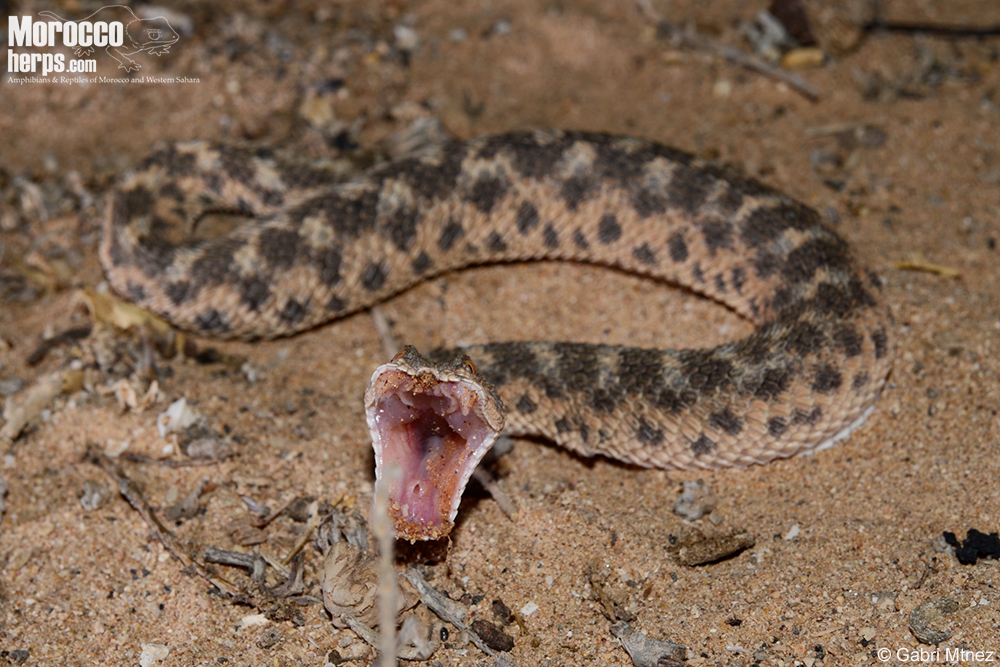
Distribution, habitat and abundance
Avicenna´s viper in Morocco is distributed from the Atlantic Coast in the West to Bouarfa in the East (Bouazza et al., 2020) with a possible continuous distribution, and it´s very likely it´s presence in other sandy areas like Figuig or the northwest of Assa.
Globally, it reaches the Sinai Peninsula and the southwest of Israel (Negev dunes) through the Sahara desert.
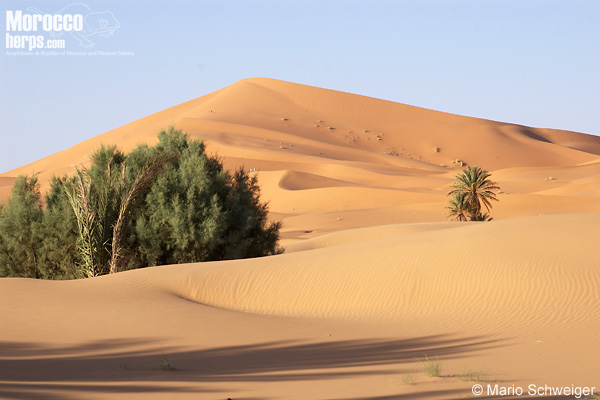
Cerastes vipera is a high specialized sand dunes dweller and therefore restricted to the sand dunes (Erg) of the Sahara. In the southwest of Morocco and in Western Sahara it also lives in coastal dunes, like in the Khnifiss Lagoon. Pure sand dunes are avoided, Cerastes vipera prefers depressions with some vegetation, where it hides below small bushes or at the edge of Halfah or Esparto Grass (Stipa tenacissima) digged in the sand, only eyes and nose out of the sand.
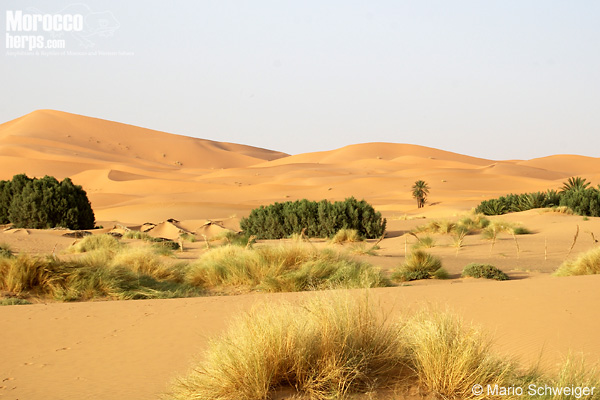
Own observations at the Erg Chebbi (Merzouga) during September showed the dunes “full” of tracks from this species, one crossing the other. This points to a quite high density of specimens, although only a few live vipers could have been seen during dark, walking around with a flashlight.
It´s conservation status in Western Sahara is Lower risk-least concern (LR-lc; Geniez et al., 2004).
References
- Baha el Din, S. 2006. A Guide to the Reptiles and Amphibians of Egypt.- The American University in Cairo Press; 360 pp.
- Bons, J. & Geniez, P. 1996. Amphibiens et Reptiles du Maroc (Sahara Occidental compris) Atlas biogéographique.- AHE, Barcelona, 320 pp.
- Bouazza, A., Laïdi, K, Martín, J. 2020. New record of the Sahara sand viper, Cerastes vipera (Linnaeus, 1758), from north-eastern Morocco. Herpetology Notes 13: 203-205.
- Crochet P-A, Leblois R, Renoult JP. 2015. New reptile records from Morocco and Western Sahara. Herpetology Notes, 8: 583-588.
- Flower, S.S. 1933. Notes on the recent reptiles and amphibians of Egypt, with a list of the species recorded from that kingdom.- Proc. zool. Soc., London 1933: 735 – 851.
- Geniez, P.; Mateo, J.A.; Geniez, M. & Petgher, J. 2004. The Amphibians and Reptiles of Western Sahara. An Atlas and Field Guide. Frankfurt Contributions to Natural History, Vol. 19; Ed. Chimaira230 pp.
- Marx,H. 1958. Sexual dimorphism in coloration in the viper Cerastes vipera L.- Nat. Hist. Misc. 164: 1-2
- Neill, W. T. 1960. The caudal lure of various juvenile snakes. Quarterly Journal of the Florida Academy of Sciences 23:173–200.
- Pasteur, G. & Bons, J. 1960. Catalogue des reptiles actuels du Maroc.- Travaux de l´Institut scientifique chérifien, Série Zoologie, 21: 1 – 132.
- Schleich, H.H.; Kästle, W. & Kabisch, K .1996. Amphibians and reptiles of North Africa. Biology, Systematics, Field Guide.- Koeltz Scientific Books. 628 pp.
- Strauch, A. 1869. Synopsis der Viperiden, nebst Bemerkungen über die geographische Verbreitung dieser Giftschlangenfamilie.- Mem. Acad. Imp. Sci., St. Petersbourg 14(6): 146 pp.
To cite this page:
Mario Schweiger (2012): Cerastes vipera (Linnaeus, 1758). In: Martínez, G., León, R., Jiménez-Robles, O., González De la Vega, J. P., Gabari, V., Rebollo, B., Sánchez-Tójar, A., Fernández-Cardenete, J. R., Gállego, J. (Eds.). Moroccoherps. Amphibians and Reptiles of Morocco and Western Sahara. Available from www.moroccoherps.com/en/ficha/Cerastes_vipera/. Version 2/08/2012.
To cite www.morocoherps.com en as a whole:
Martínez, G., León, R., Jiménez-Robles, O., González De la Vega, J.P., Gabari, V., Rebollo, B., Sánchez-Tójar, A., Fernández-Cardenete, J.R., Gállego, J. (Eds.). Moroccoherps. Amphibians and Reptiles of Morocco and Western Sahara. Available from www.moroccoherps.com.
